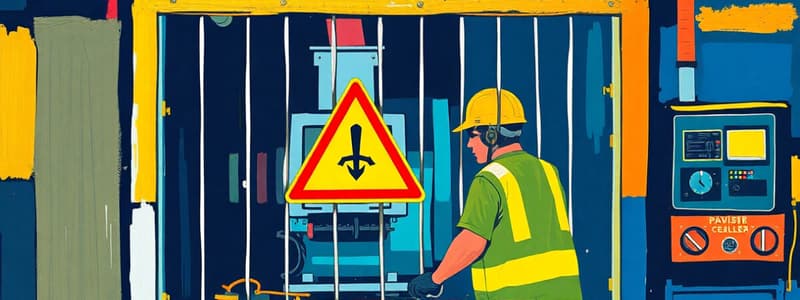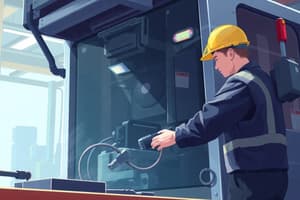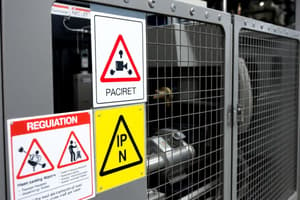Podcast
Questions and Answers
What are the primary responsibilities of electricians in controlling electrical accidents?
What are the primary responsibilities of electricians in controlling electrical accidents?
Electricians are responsible for ensuring the safe installation, maintenance, and operation of electrical systems, as well as implementing safety measures to mitigate risks associated with electrical hazards.
Why is proper lighting important in industrial settings?
Why is proper lighting important in industrial settings?
Proper lighting is vital as it enhances visibility, reduces accidents, and contributes to overall workplace safety and efficiency.
What are the key principles of good illumination in the workplace?
What are the key principles of good illumination in the workplace?
Key principles include adequate brightness, uniform light distribution, elimination of glare, and appropriate color rendering.
What is the significance of ventilation in maintaining thermal comfort?
What is the significance of ventilation in maintaining thermal comfort?
How does the concept of 5S contribute to workplace safety?
How does the concept of 5S contribute to workplace safety?
What are the key types of guards used in machine safeguarding?
What are the key types of guards used in machine safeguarding?
What is a primary consideration in manual handling to avoid injury?
What is a primary consideration in manual handling to avoid injury?
What is the purpose of built-in safety devices in machinery?
What is the purpose of built-in safety devices in machinery?
What safety aspects should be considered during the design of lifting machinery?
What safety aspects should be considered during the design of lifting machinery?
How can the risk of tool accidents be controlled?
How can the risk of tool accidents be controlled?
What are the dangers associated with electrical hazards in the workplace?
What are the dangers associated with electrical hazards in the workplace?
What is the significance of calculating safe working load for lifting devices?
What is the significance of calculating safe working load for lifting devices?
Why is maintenance important for hand tools and portable power tools?
Why is maintenance important for hand tools and portable power tools?
Flashcards
Static Electricity Hazards
Static Electricity Hazards
Dangerous buildup of electrical charge on surfaces due to friction, which can cause sparks and fires.
Electrician's Role in Safety
Electrician's Role in Safety
Electricians are crucial for preventing electrical accidents by ensuring proper wiring, equipment installation, and maintenance to avoid shocks and fires.
Good Illumination
Good Illumination
Proper lighting in workplaces improves visibility, reduces eye strain, and minimizes accidents.
Pressure Vessel Safety
Pressure Vessel Safety
Signup and view all the flashcards
5S Housekeeping
5S Housekeeping
Signup and view all the flashcards
Machine Guarding
Machine Guarding
Signup and view all the flashcards
Types of Guards
Types of Guards
Signup and view all the flashcards
Safe Lifting Practices
Safe Lifting Practices
Signup and view all the flashcards
Lifting Machinery
Lifting Machinery
Signup and view all the flashcards
Tool Accidents
Tool Accidents
Signup and view all the flashcards
Electrical Hazards
Electrical Hazards
Signup and view all the flashcards
Electrical Equipment Safety
Electrical Equipment Safety
Signup and view all the flashcards
Flame-Proof Equipment
Flame-Proof Equipment
Signup and view all the flashcards
Study Notes
Machine Guarding
- Statutory provisions govern machine guarding principles.
- Types of guards (e.g., fixed, interlocked) are designed and selected based on machine type.
- Specific precautions for woodworking, paper, rubber, and printing machinery, and machine tools are crucial.
- Built-in safety devices and routines for maintaining and repairing guards are essential.
- Incidental safety devices and tools are important.
- Plant/work area design impacts safety.
Manual Handling and Storage
- Hazards in manual handling include excessive muscular effort.
- Correct lifting/handling techniques (kinetic methods) minimize risk, and maximum load limits must be followed.
- Safe use of handling accessories is critical for objects of various shapes, sizes, and weights.
- Proper material storage reduces risk.
Mechanical Handling
- Safety considerations are paramount in the design, construction, and testing of lifting machinery (cranes, elevators, conveyors, dumpers, etc.).
- Operator training includes safe operation, signaling, inspection, and maintenance procedures for these machines.
- Power trucks and tractors require safe design features, operation, inspection, and maintenance.
- Lifting tackles (chain slings, rope slings, fiber and wire rings, hooks, shackles, swivels, eye bolts) have safety features.
- Safe working loads must be calculated for lifting tackles.
Hand Tools and Portable Power Tools
- Tool accidents are caused by factors that must be controlled (e.g., poor maintenance).
- Centralized tool control systems improve safety.
- Procurement, storage, and supply of tools are critical to safety.
- Tools need regular inspection, maintenance, and repair.
- Understanding tool failure causes (e.g., tempering needs) and proper handling, including dressing, is necessary.
- Proper handles are essential for safe tool use.
- Tool types are classified by use (metal cutting, wood cutting, etc.), including torsion tools, shock tools, and non-sparking tools.
- Portable power tools must be selected, inspected, maintained, and repaired for safe use.
Electrical Hazards
- Electricity poses hazards, with amperages, voltages, and distance from lines influencing safety.
- Conductor capacity and protection, safe joints and connections, and power-off mechanisms are essential.
- Overload and short circuit protection and earth fault protection are needed.
- Earth, insulation, and continuity tests protect against hazards.
- Precautions against overvoltage from "borrowed" neutrals are necessary.
- Portable electrical apparatus must be flameproof.
- Precautions in selecting, installing, maintaining, and using electrical equipment are important.
- Static electricity control measures are needed.
- Electricians play a crucial role in controlling electrical accidents.
- The Indian Electricity Act and Rules apply.
Industrial Lighting
- Lighting is crucial for safety and productivity.
- Good illumination provides advantages.
- Artificial lighting sources and types are various.
- Principles of good illumination (e.g., light intensity, positioning) are critical.
- Minimum recommended illumination standards exist.
- Effective lighting installation design, maintenance, lighting, and color are necessary.
Safety of Pressure Vessels
- Statutory provisions govern fired and unfired pressure vessels.
- Testing requirements and different testing types are mandated (e.g., pressure tests).
- Safety is essential in the design and construction of these vessels.
- Safety in boilers, operation, and safety precautions are key.
Ventilation and Heat Control
- Ventilation is essential for safety.
- Thermal environment measurement, thermal comfort, and indices of heat stress are all factors in safety.
- Thermal limits for comfort and efficiency, free from health risks, are essential.
- Natural, mechanical, air conditioning, and process ventilation are types of ventilation.
- Controlling heat exposures (at source, insulation, etc.) is crucial.
- Control of radiant heat and local relief are necessary.
Housekeeping
- The 5S concept (sort, set in order, shine, standardize, sustain) is crucial for safety.
- Management responsibility, safety engineers' role, and overall cooperation are vital.
- Proper planning and follow-up, and prevention of spills are critical.
- Marking gangways, etc., and use of color coding improves housekeeping.
- Clean-up campaigns, cleaning methods, employee assignments, inspection, and checklists are key.
- Good housekeeping improves safety outcomes.
- Scrap and waste disposal are important safety elements.
Special Precautions (Working at Height, Confined Spaces)
- Special precautions are required for working at height and in confined spaces.
- Work permits are necessary for such tasks.
Laws and Regulations
- Relevant provisions from the Factories Act, Indian Electricity Act, Explosive Act, and Gas Cylinders Rules must be followed.
Studying That Suits You
Use AI to generate personalized quizzes and flashcards to suit your learning preferences.
Description
This quiz covers essential regulations and practices related to machine guarding, manual handling, and mechanical handling in industrial settings. It focuses on statutory provisions, safety precautions for different machinery, proper lifting techniques, and the design of handling equipment. Test your knowledge on how to ensure workplace safety effectively.




